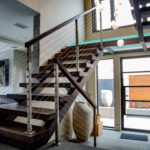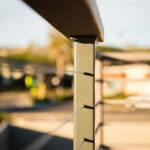Infill Spacing for Safe Decks
Building codes nationwide hold to a 4″ maximum clear spacing requirement for railing infill sections. Whether constructing new or retrofitting older barrier railings the code spacing requirement remains the same. By definition this means that no gap anywhere on the railing should exceed 4″ clear in between members. Older homes, condominiums, and commercial buildings with outdated railings may need to be upgraded in order to satisfy this requirement. Older code spacing (6″-8″) increase liability due to possible falls or injury caused by larger spacing requirements that could allow children through railing members. Newer codes and standards for child safety require tighter gapping. Safer deck railings utilize current codes with sturdy frames and max clear spacing of 4″. Cable rail spacing requires a max 3″ space to allow for deflection.
Safer Decks Require Current Codes and Practices
The 4″ maximum spacing requirement used for current codes was designed to prevent small children from being able to force their head or body into and through any gaps anywhere on the railing system. Safe railings are all about child safety requirements. In this article we will explore information necessary to upgrade your railing systems and make them safer for children, pets, and people.
Railing Heights Vary by State
Railing height specifications can vary by state and we recommend checking with current local building codes prior to construction. In California, a minimum railing height of 42″ is required. Other states like Arizona still hold to a 36″ railing height requirement.
How to measure for finished railing height?
Railing height should be measured from the top of the deck surface to the highest point of the top rail member. When performing site verifications our installers measure from multiple locations across the deck surface. Deck levels can vary, especially when dealing with slopes so it’s best to verify railing height in multiple locations.
Vertical and Horizontal Rail Spacing
Checking for voids along the railing frame is a good way to make sure your railings meet current codes. Safe deck railings should not contain any gaps larger than 4″. The following are common locations where these voids may occur:
–Upright or Vertical Members – check spacing between pickets, posts, and or pipes, also check cables for 3″ spacing compliance
–Horizontal railing members– bottom rails should be code spaced from the deck surface. Cable spacing should not exceed 3″ in order to prevent more than 4″ when deflection occurs. Solid members like pipe and/or wooden railing parts that do not deflect can be spaced at 4″ from center of member to member
Glass infill – glass panels, lattice or solid wood, steel or other aesthetic panels should not have gaps larger than 4″ in between panels or scrollwork.
Hiring Railing Pro to Construct Safer Deck Railings
A large number of our customers hire a railing professional to guarantee safety and code compliance. Our preferred installers are licensed contractors; familiar with local and current code requirements. Some custom and higher risk applications like raised decks, balconies, and stairs greatly benefit from using pro’s. Our DIY products and solutions are very popular and easy to install however some applications are better suited for hiring a specialized contractor.
HOA’s, and condo complexes are often required to use professional contractors for construction projects. Insurance claims also require the use of a professional. Large scale industrial projects, commercial, and retail spaces are best handled by licensed professionals.
Our team at San Diego Cable Railings has been fabricating and installing code compliant railings since 2009. If you are interested in learning more please give us a call or visit the quote request page to receive an estimate.






